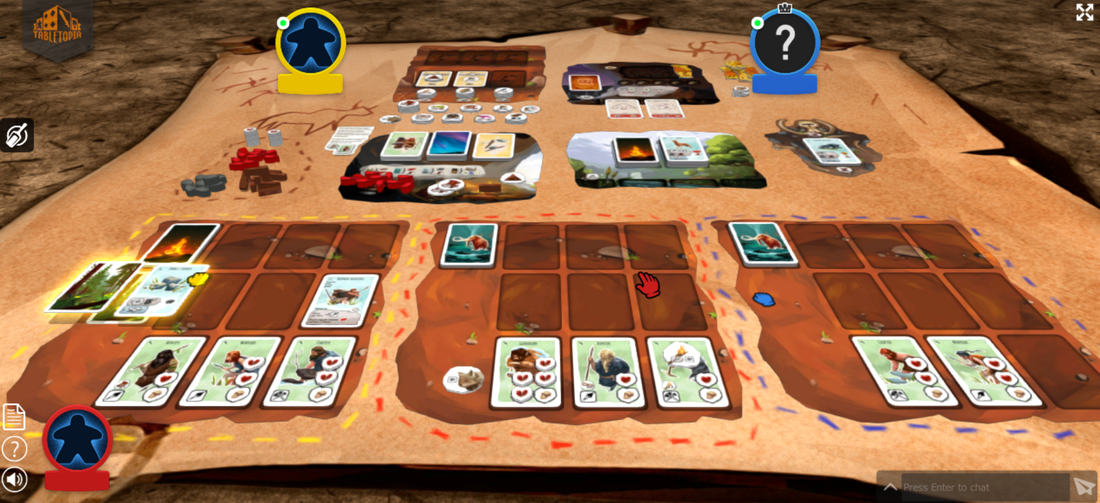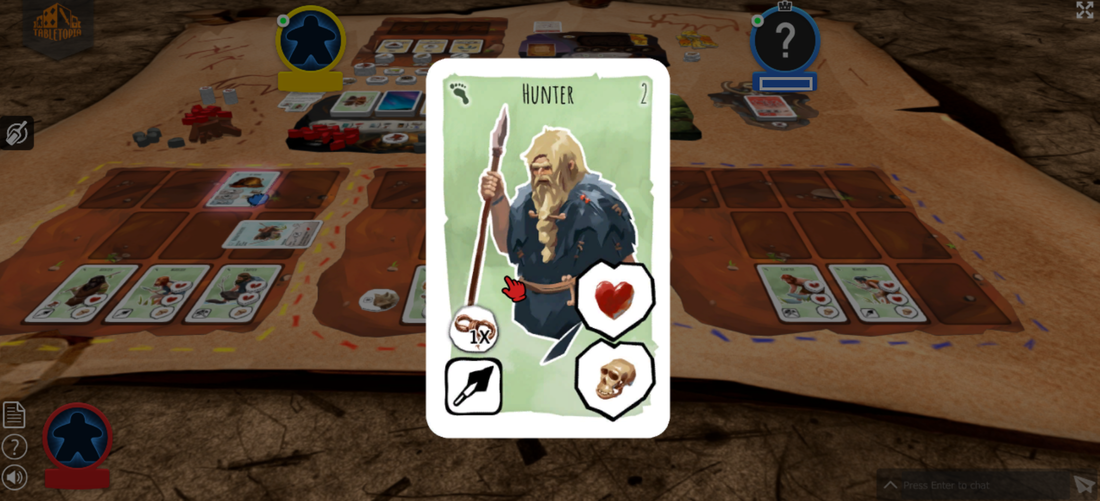|
14th March 2020 It's a Sunday night, I'm on my PC in my living, logged on to Zoom and the Tabletopia website. In Paleo each player controls a tribe of cavemen and is a cooperative card about life & times in a prehistoric times. According to Paleo, our caveman ancestors were pretty obsessed with woolly mammoths, either chasing or running away from them! Caveat: Paleo was played virtually on the Tabletopia website, so I cannot attest to the quality or lack of regarding the components. What's in a game? Paleo is a card game with a lot of different types of cards, the majority are encounter cards (Explained Below) but not all cards and tokens are used in every game. Paleo uses a base set of encounter cards and also employs a module system which determines which other sets of cards are used, each game uses 2 modules from a selection of 10, this will also affect the games difficulty. The rules suggest combinations to use for easier and harder games ranging from 1 to 7 in difficulty. Ultimately you can even choose your own set ups. Modules can add a narrative flavour to the game as most modules are themed.
Setup
How's it play? Paleo is played over any number of rounds, each round has a day phase and a night phase. The vast majority of gameplay occurs during the day phase, the night phase is mostly for managing what happened during the previous phase. Day phase What actions a player can under take will depend on the situation and what encounters they errr.... encounter!
Play continues during the day phase until all player tribes have gone to sleep, the day phase is now over and the night phase commences. Night phase The night phase is much shorter than the day. All tribes must collectively discard an amount of food equal to the number of people cards in all their tribes. If they cannot manage this, a skull is added to the night board. Furthermore they must also meet the conditions required on the 2 module specific missions. Each one they fail adds another skull to the night board. Once the night phase is concluded, all the cards on the discard board are put into a single deck, shuffled and dealt out to the players again, then the next day phase begins. Endgame Play continues until the players have accumulated all 5 victory tokens, in which case they immediately all win. If 5 skull tokens are placed on to the night board, then the players immediately lose. Some mystery cards may contain alternate ways to win the game. Overall
First thing I'm going to talk about are 2 interlinked mechanics. The exploration mechanic of drawing 3 face-down cards and choosing one from the card back is excellent. It feels a bit like exploring, does a player choose to go to the forest or the mountains? They'll have a pretty good idea what to expect but it's not guaranteed. They most likely will get the wood or stone or whatever they're looking for but they might encounter a rockfall or a dangerous animal. Additionally, players will also get an idea of what's coming in future turns It's a great mechanic. The other equally great mechanic is how each player's own deck also represents their tribe's time & energy, completing encounters frequently forces a player to discard 1 or 2 cards from their deck, so when it's depleted - so is the tribe for the day. When the game begins on day 1, players will have 15 cards, so it's possible to burn through a deck very quickly, why is that significant? Essentially the encounter deck is another resource that needs to be managed. In most games, my instinct would be to gather as much food/wood/stone/resource as possible but in Paleo you sometimes have to fight that urge. You have to ask the question, what resource do I really need? For example; near the end of a day I had 3 cards left, 2 in my deck and a forest encounter. Turning the card over, I had the option to discard 2 cards for 3 wood, 1 card for one wood or help another tribe. The others didn't need help from me, so I was free to collect wood but collecting 3 wood would send my tribe to bed. Because we knew the top 2 cards on everyone's deck, I knew that another player potentially had a mammoth hunt coming and would probably need help. We didn't need the wood for now so I chose to ignore my card and I also ignored my other 2 encounter cards just so my tribe would be around for 3 more turns to help other tribes if needed. Realising this gave me an appreciation of the game's subtleties. As well as managing encounters, players will need to ensure they generate enough resources to pass the night as well manage discoveries and crafting. Creating a few tools gives the game a good sense of progress as it increases the capabilities of a tribe significantly. You can almost feel a the game transition from scrabbling to survive encounters to being able to go on mammoth hunts, it's quite gratifying to complete encounters that had to be ignored earlier in the game. Like all good games, collectively there were always meaningful decisions to make. Before long we learnt that we needed to communication and coordinate on which encounter cards to keep and when they were then revealed we frequently had to coordinate on which encounters to complete, rarely did all players manage to individually complete their encounters. For example; if all players for some reason chose mammoth hunt encounters, it would be most likely that all bar one would be ignored. Mammoth hunts generally required a lot of strength thus cooperation but also gave significant rewards, including on occasion victory tokens. Coordination is vital and it feels like players coordinating. As a result I liked Paleo quite a lot, it's a game I'd happily play again.
0 Comments
Leave a Reply. |
AuthorI play, I paint. Archives
March 2024
Categories
All
|



 RSS Feed
RSS Feed
